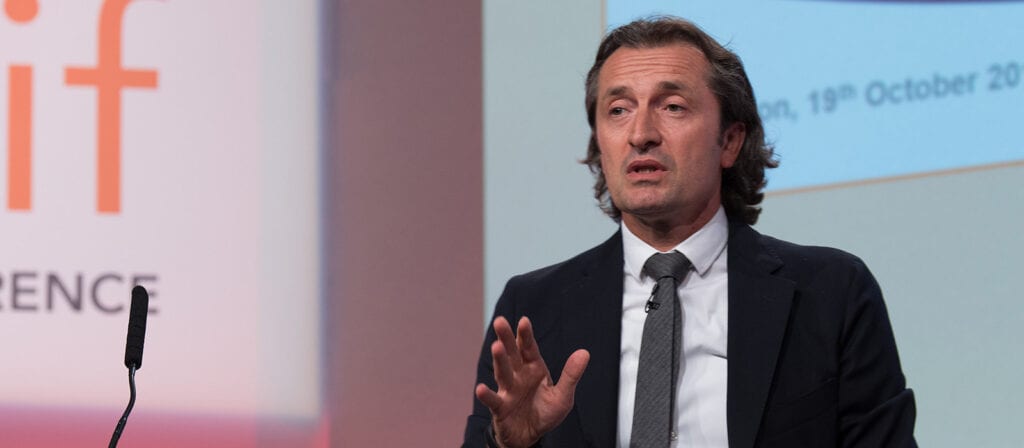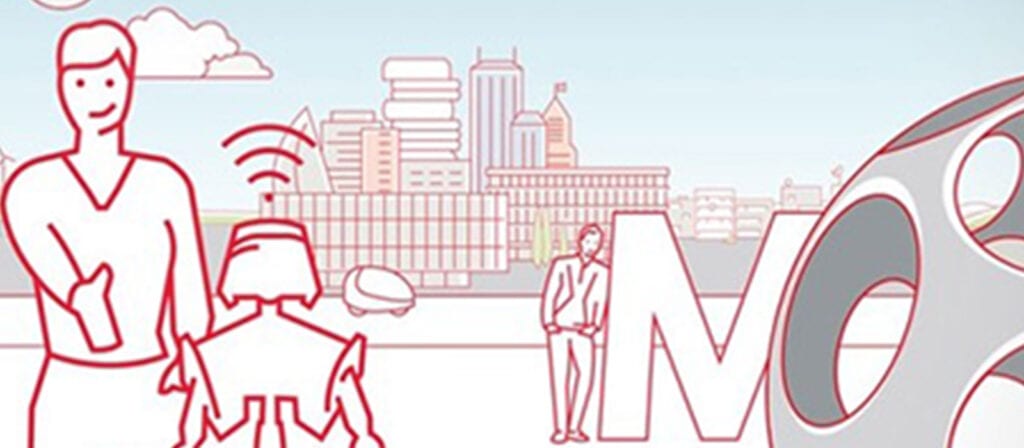Ben Telfer:
Everyone, and welcome to today’s ICMIF webinar, “Innovation as an opportunity”. Today we will hear from Italian ICMIF member Unipol, and hear from their innovation experience and some examples of new innovation solutions that help Unipol’s commitment to respond to society’s changing social needs. I’m pleased to introduce today’s speakers. Firstly, we have Renzo Avesani, he is chief innovation officer at the Unipol Group, and also Lorenzo Cordin who is the innovation manager, specializing in digital and open innovation. Renzo, Lorenzo, thank you for joining us today and over to you.
Renzo Avesani:
It’s a pleasure to be here with you tonight, and I’m happy to talk about something that has been very much at the core of my activities in the last four to five years. Actually as you notice, we little bit changed the subtitle of this seminar, and now we are more strong on the message, because we are saying that “innovation is the ONLY opportunity” we have in order to face the challenges that are coming from this very complex world that is under our eyes, in these days. As a matter of fact, as we say, we are during the fourth industrial revolution. That this revolution is going to change fundamentally the way we live and work and relate to one another.
This revolution as we say is not only technological, but has very important social and political and environmental aspects. The crucial factors that we have to keep in mind in this revolution is the fact that… I mean, what characterized the evolution of this revolution is the fact that these kinds of events sort of keep quiet for a while, while they are working, and then all of a sudden they explode and they acquire a velocity that you cannot control anymore. And while it is difficult to anticipate them while they are cooking, when they are ready, they have a take off power that is very very strong. And that is what has been happening in fact with the things that the Big Tech companies have done in the last few year.
Big Tech are the originator of the new data economy. They are the ones who have defined the new economy as a data economy, and they are maintaining the leadership in this, because in this process they have acquired an enormous amount of information, that they are still exploiting and on which they are building new opportunities for their own development, both in the financial and the insurance space. The Big Tech have acquired a large customer base, they have a scale of operation that is enormous because they are operating worldwide. They have a tremendous agility in adapting system and services to what are the demand that are coming from the market, in particular the user.
They have acquired through the years, an enormous amount of financial resources. Their growth at this point is difficult to see as limited, and the velocity by which they are entering different fields is really incredible. We know the big names that we have listed here, Google, Apple, Facebook, Amazon, Microsoft, all of them have in one way or another tried something in the financial insurance space, by specific offering, by providing platform, by providing their knowledge to new ways in which this space can be further developed.
I would like to stress in particular, the fact that they have an enormous advantage with respect to anybody who wants to enter in the data economy space, because, I mean, they have created it by themselves. And so they know it, from the very beginning how you have to work. So the platform on which they are based is the fundamental asset. Their platform are extremely flexible. They are extremely capable of developing new solution, responding on a day to day basis, on evolving customer needs. And therefore this is posing us as insurance sector a tremendous challenge, because usually as insurer, we have IT system, legacy IT systems that are very structured and very much and older, and therefore they are incapable to keep up with the pace of innovation that is needed in order to compete in this market.
In order to face this challenges, Unipol Group develop a strategy, that these based on making Unipol a data company. And one of the instrument that Unipol is using is Leithà. Leithà is a company completely controlled by Unipol, was founded in 2016, and the concept behind that is that, is a solution factory that supports the operation of the entire Unipol Group. It is very important to notice that as a factory, there are some input which on one side are the data, the data that Unipol has, because as an insurance company, we collect enormous amount of data on our customers. But also, that we have data that we can collect outside of Unipol, from the social networks or other public and private institutions.
But the idea of Leithà is exactly the fact that we want to leverage on the data that are available to an insurance company. We want to protect, enrich and exploit these data assets, by merging them with the specific skills, skills that are capable of using those data in the most efficient way. Within Leithà, we have basically two basic skills. One is the data science skills, and the other one are the skills of a computer science, all of them. And we let our guys to think and work on the data of the company, with the idea that they have to come up with solutions that are needed, asked by the operational lines.
These guys operates in a way that is very similar to the one that we have understood that is typical of the tech company. So they work on a platform that they have built on their own. And they provide solution SaaS, through this platform, as a service to the different business line, we are organizing agile team, and we have a portfolio of activities and project that ranges across several, and almost all the business line of the company. Today, just to give you an idea of what we have done and we are doing, we are going to propose some examples of the new solution that we have developed, and that are operational in this point, within the Unipol Group framework.
The first one is a very simple idea, and it is a suite for simple and interactive web communication with customers, in which we are able to notify customers that some events has happen, and based on data, we are able to convey information if we need, or to collect documents, upload forms, or filling out documents that needs to be filled out in the insurance space. This application can be activated by SMS or mail, or app notifications. So it is very flexible. We are tailored to be integrated into the most common way to communicate with the customer. We don’t need apps in principle, but a simple SMS can activate the interaction with the customer, then we will see some of them in the coming minutes. Clearly, this application is integrated with the basic business tool, the legacy business tools such as the CRM or the Claim Center.
Ongoing projects on which we are applying part of this technology, it’s the real time crash management process, weather hazard management, natural events, and at the same time in the end, the application that have to do with the smartphone telematics, on which Lorenzo is going to drive you through. For an insurance company, one of the most crucial process is the claim management, and since as you know, in Unipol we have one of the largest implementation and distribution of black boxes installed on cars. We decided to further develop the claim process, leveraging on the information that we collect through our black boxes. We have a cursor that send messages to us when a crash happen, therefore at that point say that our processes are triggered, in particular we might have the traditional call, which is a call that is done by our central operation deck.
And at the same time, we also can send an SMS to our client, that is at that point facing an accident. And the first question that is asked is, it seems to us that your car with the specific plate is having an accident, is that true or not? So the first step which is really very important, is to understand and have a confirmation that is done in real time, by our client, if in fact we are in an accident or not, and that allows us to eliminate cases in which we should intervene or not intervene.
This process is further followed by providing to our customer through the telephone, the details of the event, and in case we have a confirmation that in fact a crash has happened. And so we might reconstruct part of the dynamic of the event and we send it over to our client. And then we help our clients in filling out a form, which is a confirmation of the dynamic of the event. In Europe, we have the European Accident Statement, that is a predefined form, and that given our ability to identify the vehicles and identify the dynamic of the claim, we can pre-fill out the form, ask if the customer is happy with the kind of filling out that we have done, and ask him to fill out the rest of it. And in the very end, to also sign it, so that the claim settlement process can be initiated at the very moment in which a few moments after the accident took place.
We have systems that allows us to make a preliminary crash assessment, understanding the velocity of the cars involved, and even the body injury that we estimate could be likely linked to the kind of velocity and dynamics of the accident. So the kind of reconstruction that we can make through our system is quite interesting and is quite complete, so that allows not only our client to confirm the dynamics online, but also help our claim assessor to add in their end a lot of information, in the moment in which they have to go to liquidation.
Another example, as I said before, is the weather as a management, in this process we collect a lot of real time and the historical weather data. We have a model that forecast with the machine learning technique, the kind of evolution that we might expect and the kind of intensity we might expect from a certain weather event. And leveraging on the data that we collect with partnership with the private and public entity, we can give information to our customer. This can have a large amount of useful output. We can have better estimation of the risk for capital management and underwriting. We can based on this information, optimize our pricing strategy. We have faster evaluation of the natural events impact, and we can also, among others, develop innovative insurance products, for example index-based policies. Very important among these different outputs is, are the loss prevention services for policyholder that we can provide.
This brings me to the other application, which is sort of weather alert that we can send out using the Vitruvius platform to a select subset of our customer, the ones that we think based on our evaluation can be impacted by a certain extreme event. This has been particularly useful during this summer in Italy, where we had several hail events, so that were particularly damaging. Moreover, we can send also statistics and severity of claims that we have analysed, during normal days. What is very important in this kind of exercise is that in order to be effective and not to bore or distract our customer, is that we need to have a very high level of accuracy, in particular in weather forecasts, having an accuracy of higher than 70% of cases is a good statistics.
There are two other applications, of new solution that we have developed for natural events, so that I would like to mention, and then I will pass the mic to Lorenzo, and is the building of a higher resolution flood hazard mapper, that we have been able to develop jointly with a scientific partner, which has been the University of Bologna, that will enable us a better assessment of the risk for underwriting and economic capital management, and optimize our pricing strategy. Another application of these maps have been the building of earthquake risk assessment tool, which again, is a nice tool to entertain our customer in the moment in which they are about to sign on a policy for earthquake. But also gives a lot of information to our underwriters, in order to be better informed on the kind of risk they are underwriting with a specific client, that is localized in a specific point. I mean, finally, this has been also useful, act as an after event kind of tool, in order to be able to better assess what has been happening. And now, and let me pass you to Lorenzo.
Lorenzo Cordin:
Thanks, Renzo. In Unipol we have, as you probably know, over 10 years of history in car telematics, and we recently reached over 4 million black box installed in our clients’ car. Being a leader in telematics, that we showed before a different use case in which we used this kind of data, we collect automatically to trigger action, like for example, an automatic claim notification to the client. Of course, we also have to monitor new trends and technology that are coming in this kind of fields, that can eventually integrate the data we currently collect through black box with other kinds of data. In this kind of field, we started a couple of projects, and the first one is with Linear.
Linear is the direct channel insurance of the Unipol Group. And we launched in May 2018, Linear BestDriver. And the app was… Let’s say the goal to explore particularly to prospects and Linear clients, the distraction. So the focus of the project was on distraction during driving. So of course, what is distraction? Mainly distraction is based by phone active user during driving. And of course this could be texting, messaging, and this kind of application that actually distract the driver. And on 20% it could be, for example, because driving, but without speaker or Bluetooth. And recently statistics showed that careless driving and distraction accounts for approximately 25% of accidents. So of course it’s really an important issue to target.
In May 2018 with Linear, the app was developed by Linear together with Leithà. And we launched the app, thanks to the collaboration with a famous Italian YouTuber that helped to spread, also with the social responsibility impact, the solution. And we reached over 100,000 downloads. And so far we collected over 5 million trips. The app is quite easy, easy from the user perspective of course, and we show the user, it collects through accelerometer, GPS and gyroscopes, the mobility patterns of the user. And of course the distraction, that is actually the main new kind of data asset we collect through this kind of process, that we cannot currently of course collect through a standard black box.
We provide to the user a score, the monthly historical, let’s say trip history, so all the trips he has done. And of course a score that match the distraction and his driving behaviour. Of course to engage clients, there was a pricing contest, let’s say, so a user could be rewarded if he had, let’s say highest score, of course he could get, for example, an Amazon voucher, and some kind of reward. Of course, as I mentioned, we already collect a few million trip and we already have some insight to share. So as a first insight, and it’s something that actually we could expect, but now we have the data, so it’s not just an opinion to validate this.
Distraction and the crash frequency are directly proportional. So the more a user is distracted, and we could actually measure this, the more the crash frequency increase. And on the other side, the score and the crash frequency are inversely proportional, because as you can imagine, the safer you drive the higher is your score. On the other side, this is a project that is more recent because it was launched in December 2019, so just a few months. And in this case, the target was a UnipolSai customer based, and in particular policy holders that had also a black box installed in their cars. So they are a telematic insurance. We engage with them, thanks to the Vitruvius, let’s say multichannel solution, Renzo explained before.
Through an SMS and the landing page, we propose them to engage with us and test this newer solution. Let’s say the focus was more into co-creation. So we wanted to do involve directly the user in a co-creation environment, having frequent feedback with them, that could also in an agile environment enrich and guide the development of the future features of the application. So the application, briefly it can of course collect the trips, and we ask the user to actually confirm that the minimum transport that the app collected and detected is correct. So of course, let’s say to maximize the feedback collected, there was a reward program connected, and the most a user provides feedback to our app, the most that they can have the opportunities to participate to a lottery.
For example, one of the feedback we ask is, which is the next feature they would like to have in this kind of an application. So in a really minimal viable product approach we can decide to focus our internal effort and the skill set to actually develop what really the user would appreciate and would really want to have in their application. Then of course, the goal is to benchmark the telematics solution, and of course in this case that we did not have before with Linear, we also have the true line, that is of course what we collect through standard telematics, sort of black box in the car.
On the other side, is really interesting because from this application we collect the mobility, not just of the user when he’s driving his own car, but actually a more wider pattern of mobility than in this kind of trend, of sharing mobility. And more and more people are multi vehicles, so they use more and different ways to actually move. And so of course it’s important to have the smartphone as a, say a sensor, to integrate to what actually is collected by the standard telematic black box.
Of course even here there is a reward and a gamification approach, the next picture of what we see in the future is of course to move from what now is a reward to have a policy discount, or even maybe for some kind of clients, a telematic insurance product, or even this kind of solution could have some value in a try before you buy approach, to actually be able to estimate the risk of a prospect, simply having them install an app and using it while they’re, let’s say everyday mobility for a couple of months. And we actually detected that the cap in one or two months, you already kind of are able to detect which is the driving behaviour of a person. So this kind of solution could be used even for a pricing, to have a really personalized and customized pricing for a prospect.
Briefly, doing a recap of what Renzo previously mentioned, of course to face this new challenge that are posed by the fourth industrial revolution, we must dare to shift from being protection providers to predict and prevent, offer more and more personalized insurance and automate processes. Thanks for your attention.
Ben Telfer:
Thank you Lorenzo, and thank you Renzo for this excellent presentation. We’ve got a number of questions in, so please if you do have any that you’d like to ask Renzo and Lorenzo, please type them in and hopefully we’ll get a chance to ask them. Firstly, question probably for you Lorenzo, based on what you’ve just presented. Do you see that in the future people using the app will replace the black box technology that you have installed in the motor vehicles?
Renzo Avesani:
Well, that is a difficult question, in the sense that we fully understand that it is quite a peculiar situation that we are having in Italy. Black box have been a huge market in Italy, but not much in other parts of the world, in the sense that we are using the black box for crash reconstruction mainly. Whereas in other parts of the world, the boxes that are being used are mainly for pricing purposes. Nowadays, the situation is that given the development of the smartphone technologies and the SDK that are connected with data, there is the possibility probably to be able to arrive at a crash reconstruction algorithm, that perform not far apart from the box.
So it is going to be pretty much a question of how our clientele is going to respond to this new situation. We will be clearly still using the boxes for a while, I would say. We see the use of a smartphone as the same sort of as an intermediate situation, because we all know that in due time the new cars that are coming into the market are going to be connected cars, and so there are going to be a lot of information that could be extract from the data that by default the cars already collect.
Ben Telfer:
On the subject of data, we have another question that looks at sort of the ethical considerations of using data. And the question asks that, since you started using these data intensive solutions from 2016, have you seen any changes due to the new data protection regulation, come in recently?
Renzo Avesani:
Well, we are paying attention to all of this, because we are out with the 4.5 million boxes, and so we have to be very careful. Of course the new GDPR is imposing constraint on the way in which we manage data, just to say, one, that is particularly difficult for us to accept is the fact that after a couple of years we have to cancel the data or anonymize them, which poses completely different challenges. So is a situation in which we feel a little bit uncomfortable, because as I said before, we are facing a situation in which the Big Tech have been able to collect data, all sorts of data, in all different ways for 10 years now without any constrain.
Now that everybody else is trying to build the algorithm based on machine learning, that of course needs a lot of history in order to be tested and in order to be implemented. Now we are facing problems because we cannot collect the data as freely as they were available before. So we pay a lot of attention to ethical issues. At the same time, we have to understand that if we have the data we can provide to our customer better services, and if this is what the clients want, we have to be able to provide them because we have the feeling that either we do it or somebody else is going to do it.
Lorenzo Cordin:
I’d like to add a few words here, that, of course we put in place a process in which even from the pilot stage we have to be fully compliant. So we have some kind of check that we do even within innovation stage, that is of course to be privacy by design, or we have a data privacy spectre assessment to do, when we kind of process new kind of data or a kind of data that could be particularly sensitive. So of course, let’s say that we try to be compliant from the very beginning, because of course, if there is something that could not be done, it’s better to know it from the very beginning of the project and not only to a later stage.
Ben Telfer:
Thanks Lorenzo, and thank you Renzo. What is your typical timescale with developing any of the new solutions that you’ve just mentioned, and how many people would you say directly work on these innovative solutions?
Renzo Avesani:
Well, everybody here at the company, at Leithà is working. So we have around 50 people and they are day and night working on these kinds of applications. We try to be very quick in devising a solution, because otherwise you become old, obsolete very quickly. A project typically is three to four months, from inception to production. One important thing that I might not have underlined before is that, Leithà decided that the process that you typically expect, that goes through a proof of concept kind of phase, and then you have a prototype and then eventually you ask to someone to industrialize the solution, is not a viable process.
And therefore, when we start operating on something, we operate in such a way that the solution that we have at the end of the three, four months, is fully scalable, at the production level. So this is part of what we have learned by looking at what the Big Tech are doing. So in some sense, your application is a sort of a product that is evolving every day, but from the very beginning is something that is completely scalable and integrated in the production flow of the company, of company, meaning of Unipol Group.
Ben Telfer:
Thank you Renzo. We do have a question about Big Tech, and the future of insurance, but I’m going to save that one till the end, and just focus on something that you mentioned about how Unipol have built your app. And the question is, was this done through partnerships or is it a self-made Unipol app?
Renzo Avesani:
In this app what we did, because we did an app, at the moment the technology, we partnered with some of people that are currently providing SDK for mobile phone, for telematic services to insure. There are several, they are in competition among them. We tried and tested several of them. And that we are in the process of developing our own SDK, because we think that there is value in doing that. So the answer is, we partner with someone in order to understand how to do it, but the scope in the end is in having something that is completely own, because we know that there is value in the data that we collect for that instrument. And we want to keep the value of those data completely within our full control. So this is the philosophy, you need to have platforms that allows you not to disseminate the kind of data that you collect in your applications.
Ben Telfer:
Thank you Renzo. This question probably refers to the wider Unipol Group. How do you ensure your employees view the new technology as an opportunity rather than a threat to their job security, and especially those that aren’t technologically savvy?
Renzo Avesani:
Well, it’s very difficult, is a very difficult process. We have set up within Unipol an academy, that has this main aim to refocus the skills of the different people of Unipol, in this new environment driven by technology. So what we are constantly doing is, to reskill people in order to be able to be used in the new situation. Is not an easy process, is not something that you reach overnight, but we are addressing that through basically reskilling of the people in the production lines.
Ben Telfer:
Another question, that’s almost two questions merged together. How do you see Unipol’s approach to innovation differ to other insurance companies in Italy because of your co-operative and mutual heritage? And sorry, and do you see that this provides an advantage over other competitors in the Italian market?
Renzo Avesani:
Actually I don’t know. Unipol is a strange beast actually, because we are a quoted company with the co-operative at the shareholder level. So we are completely private entity quoted in the market, and with the shareholding structure. The co-operative may use part of the technology that we develop, and can clearly have some advantages in having this solution within their control. And of course there is a return from that for us, because the number of clients that the co-operative movement has in Italy is quite wide, and therefore all these processes are processes in which you need a large number of customers and huge amount of data to work on. So in this sense, I think that there is a benefit of being part of the co-operative movement.
Ben Telfer:
Renzo, just a follow up question to that, do you see other Italian insurers as well, the insurers in your market developing similar, sort of social innovations or moving from protection to prevention in the same way that Unipol are?
Renzo Avesani:
I mean, everybody is doing something in innovation. So everybody is trying their own ways. There is a lot of competition. Clearly there are some fields in which being the beast we are it is an advantage, in particular in the health insurance space, where Unipol is a clear market leader, as well as in the car insurance. So where we are leaders, it is easier I think to be able to develop new solutions.
Ben Telfer:
Thank you Renzo. And so we’ve just got time for one final question, and it relates to Big Tech. Do you think Big Tech will start selling insurance policies, or will they start providing new services that will disrupt how insurers typically sell insurance policies?
Renzo Avesani:
This is my personal view of this market, I think that Big Tech of course will sell insurance policy. They are already doing that by the way, in some specific segment of the market. But the insurance process is very complicated, and in particular, the settlement process is particularly complicated. And where I see a clear advantage of the Big Tech on the selling side, what’s come after, in terms of customer support and claim settlement, I think that the insurer have still an advantage, an advantage that cannot be breached so easily. And therefore, I think that we will see a very successful classical insurer being able to survive in this environment, if they focus on automate, and be faster, and being close to their customer in the settlement process.
Ben Telfer:
Thank you Renzo. And I think the last slide that you shared, about the sort of a dare to shift from being protection providers to prevention, personalized service and automated processes, is something that, hopefully our audience will go away with and think about within their own organizations. Thank you Renzo, Lorenzo, for joining us today. And thank you for everybody who’s joined, watching. Before you leave, just a reminder that all of our webinars are recorded and if you’ve registered for this webinar you will be directly sent the link to watch the recording.
Thank you for everyone who’s joined in today, and enjoy the rest of your day. Goodbye.
The above text has been produced by machine transcription from the webinar recording. ICMIF has made every effort to ensure that transcriptions are as accurate as possible, however, in some cases some text may be incomplete or inaccurate due to inaudible passages or transcription errors. Listening to or watching the webinar recording will allow you to hear the full text as delivered during the webinar but this is available in English only. Our transcriptions are provided to enable members to select the language of their choosing using the dropdown menu above.





